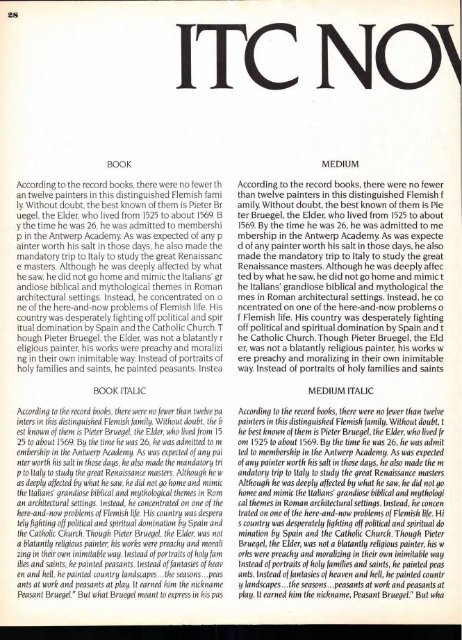Volume 12–4 (Low Res).pdf - U&lc
Volume 12–4 (Low Res).pdf - U&lc
Volume 12–4 (Low Res).pdf - U&lc
Create successful ePaper yourself
Turn your PDF publications into a flip-book with our unique Google optimized e-Paper software.
28<br />
BOOK<br />
According to the record books, there were no fewer th<br />
an twelve painters in this distinguished Flemish fami<br />
ly. Without doubt, the best known of them is Pieter Br<br />
uegel, the Elder, who lived from 1525 to about 1569. B<br />
y the time he was 26, he was admitted to membershi<br />
p in the Antwerp Academy. As was expected of any p<br />
ainter worth his salt in those days, he also made the<br />
mandatory trip to Italy to study the great Renaissanc<br />
e masters. Although he was deeply affected by what<br />
he saw, he did not go home and mimic the Italians' gr<br />
andiose biblical and mythological themes in Roman<br />
architectural settings. Instead, he concentrated on o<br />
ne of the here-and-now problems of Flemish life. His<br />
country was desperately fighting off political and spir<br />
itual domination by Spain and the Catholic Church. T<br />
hough Pieter Bruegel, the Elder, was not a blatantly r<br />
eligious painter, his works were preachy and moralizi<br />
ng in their own inimitable way. Instead of portraits of<br />
holy families and saints, he painted peasants. Instea<br />
BOOK ITALIC<br />
According to the record books, there were no fewer than twelve pa<br />
inters in this distinguished Flemish family. Without doubt, the b<br />
est known of them is Pieter Bruegel, the Elder, who lived from 15<br />
25 to about 1569. By the time he was 26, he was admitted to m<br />
embership in the Antwerp Academy. As was expected of any pai<br />
nter worth his salt in those days, he also made the mandatory tri<br />
p to Italy to study the great Renaissance masters. Although he w<br />
as deeply affected by what he saw, he did not go home and mimic<br />
the Italians' grandiose biblical and mythological themes in Rom<br />
an architectural settings. Instead, he concentrated on one of the<br />
here-and-now problems of Flemish life. His country was despera<br />
tely fighting off political and spiritual domination by Spain and<br />
the Catholic Church. Though Pieter Bruegel, the Elder, was not<br />
a blatantly religious painter, his works were preachy and morali<br />
zing in their own inimitable way. Instead of portraits of holy fam<br />
ilies and saints, he painted peasants. Instead of fantasies of heav<br />
en and hell, he painted country landscapes... the seasons... peas<br />
ants at work and peasants at play. It earned him the nickname<br />
Peasant Bruegel." But what Bruegel meant to express in his pas<br />
TC NOS<br />
MEDIUM<br />
According to the record books, there were no fewer<br />
than twelve painters in this distinguished Flemish f<br />
amily. Without doubt, the best known of them is Pie<br />
ter Bruegel, the Elder, who lived from 1525 to about<br />
1569. By the time he was 26, he was admitted to me<br />
mbership in the Antwerp Academy. As was expecte<br />
d of any painter worth his salt in those days, he also<br />
made the mandatory trip to Italy to study the great<br />
Renaissance masters. Although he was deeply affec<br />
ted by what he saw, he did not go home and mimic t<br />
he Italians' grandiose biblical and mythological the<br />
mes in Roman architectural settings. Instead, he co<br />
ncentrated on one of the here-and-now problems o<br />
f Flemish life. His country was desperately fighting<br />
off political and spiritual domination by Spain and t<br />
he Catholic Church. Though Pieter Bruegel, the Eld<br />
er, was not a blatantly religious painter, his works w<br />
ere preachy and moralizing in their own inimitable<br />
way. Instead of portraits of holy families and saints<br />
MEDIUM ITALIC<br />
According to the record books, there were no fewer than twelve<br />
painters in this distinguished Flemish family. Without doubt, t<br />
he best known of them is Pieter Bruegel, the Elder, who lived fr<br />
om 1525 to about 1569. By the time he was 26, he was admit<br />
ted to membership in the Antwerp Academy. As was expected<br />
of any painter worth his salt in those days, he also made the m<br />
andatory trip to Italy to study the great Renaissance masters<br />
Although he was deeply affected by what he saw, he did not go<br />
home and mimic the Italians' grandiose biblical and mythologi<br />
cal themes in Roman architectural settings. Instead, he concen<br />
trated on one of the here-and-now problems of Flemish life. Hi<br />
s country was desperately fighting off political and spiritual do<br />
mination by Spain and the Catholic Church. Though Pieter<br />
Bruegel, the Elder, was not a blatantly religious painter, his w<br />
orks were preachy and moralizing in their own inimitable way<br />
Instead of portraits of holy families and saints, he painted peas<br />
ants. Instead of fantasies of heaven and hell, he painted countr<br />
y landscapes...the seasons...peasants at work and peasants at<br />
play. It earned him the nickname, Peasant Bruegel." But wha
















